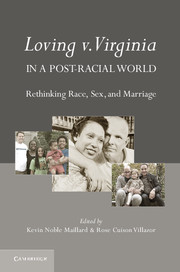Book contents
- Frontmatter
- Contents
- About the Contributors
- Acknowledgments
- Foreword
- Introduction Loving v. Virginia in a Post-Racial World
- Part One Explaining Loving v. Virginia
- 1 The Legacy of Loving
- Part Two Historical Antecedents to Loving
- Part Three Loving and Interracial Relationships: Contemporary Challenges
- Part Four Considering the Limits of Loving
- Part Five Loving Outside the U.S. Borders
- Part Six Loving and Beyond: Marriage, Intimacy, and Diverse Relationships
- Permission Granted
- Index
- References
1 - The Legacy of Loving
Published online by Cambridge University Press: 05 July 2012
- Frontmatter
- Contents
- About the Contributors
- Acknowledgments
- Foreword
- Introduction Loving v. Virginia in a Post-Racial World
- Part One Explaining Loving v. Virginia
- 1 The Legacy of Loving
- Part Two Historical Antecedents to Loving
- Part Three Loving and Interracial Relationships: Contemporary Challenges
- Part Four Considering the Limits of Loving
- Part Five Loving Outside the U.S. Borders
- Part Six Loving and Beyond: Marriage, Intimacy, and Diverse Relationships
- Permission Granted
- Index
- References
Summary
What has Loving v. Virginia meant in American law? Loving’s legal and doctrinal legacy is threefold. Loving has been used to define and affirm the fundamental right to marry, to enforce federal constitutional limits on domestic relations, and to invalidate racial classifications and other practices that perpetuate racial subordination. Before Loving, the Supreme Court’s role with respect to marriage law was limited to refereeing conflicts among the states, who had long differed over the substantive restrictions on marriage, and, even more stridently, about the accessibility of divorce. Increasing mobility and the rise of divorce mills made conflicts between states about the proper regulation of marriage and divorce a common occurrence, disputes that reached the Supreme Court’s doorstep on occasion. Through those decisions, the Supreme Court – and, to a greater extent, lower federal and state courts – developed an approach to interstate recognition that drew on notions of comity, pragmatic considerations about the need for portable personal status, and, where applicable, principles of the Full Faith and Credit Clause.
There was no federal law norm about the right approach to regulating marriage and divorce before Loving, and thus no substantive principles for the Supreme Court to bring to bear on the few family law cases it heard. This limited involvement was thus consistent with the long-standing belief that domestic relations law was reserved to the states. Indeed, prior to Loving, the Supreme Court had invalidated not a single state marriage or divorce law, despite significant variations among state codes, and had often made clear its belief that marriage was a matter for the states to regulate. As Justice Field wrote in Maynard v. Hill, an 1888 case involving the validity of a legislative divorce granted by the Oregon Territory to a Vermont husband, “Marriage … has always been subject to the control of the legislature.” Pre-Loving, then, the Supreme Court’s deference to state substantive norms regarding marriage was essentially complete. Thus, by invalidating under the U.S. Constitution a state law that restricted marriage based on race, Loving heralded a new era for the Supreme Court by including federal constitutional norms within an area – domestic relations – that traditionally fell within state domain.
- Type
- Chapter
- Information
- Loving v. Virginia in a Post-Racial WorldRethinking Race, Sex, and Marriage, pp. 13 - 26Publisher: Cambridge University PressPrint publication year: 2012



